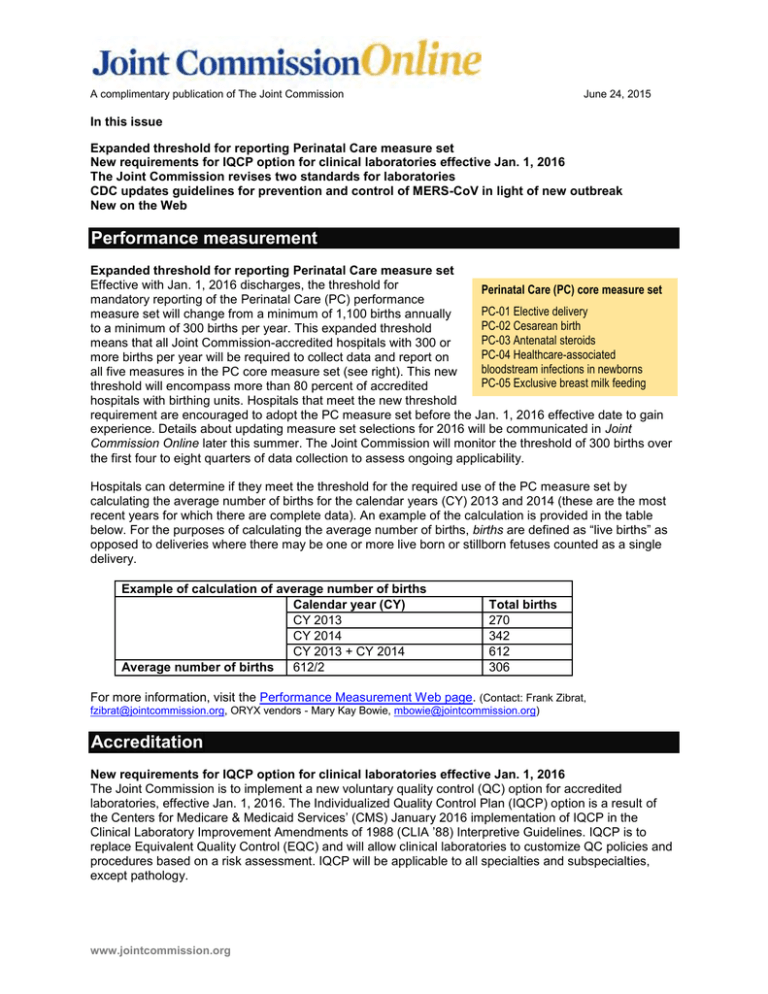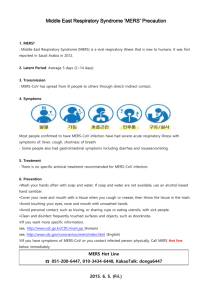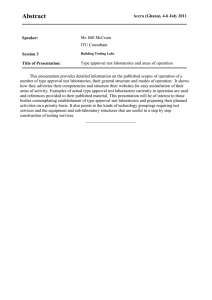In this issue Expanded threshold for reporting Perinatal Care measure set
advertisement

A complimentary publication of The Joint Commission June 24, 2015 In this issue Expanded threshold for reporting Perinatal Care measure set New requirements for IQCP option for clinical laboratories effective Jan. 1, 2016 The Joint Commission revises two standards for laboratories CDC updates guidelines for prevention and control of MERS-CoV in light of new outbreak New on the Web Performance measurement Expanded threshold for reporting Perinatal Care measure set Effective with Jan. 1, 2016 discharges, the threshold for Perinatal Care (PC) core measure set mandatory reporting of the Perinatal Care (PC) performance PC-01 Elective delivery measure set will change from a minimum of 1,100 births annually PC-02 Cesarean birth to a minimum of 300 births per year. This expanded threshold PC-03 Antenatal steroids means that all Joint Commission-accredited hospitals with 300 or PC-04 Healthcare-associated more births per year will be required to collect data and report on bloodstream infections in newborns all five measures in the PC core measure set (see right). This new PC-05 Exclusive breast milk feeding threshold will encompass more than 80 percent of accredited hospitals with birthing units. Hospitals that meet the new threshold requirement are encouraged to adopt the PC measure set before the Jan. 1, 2016 effective date to gain experience. Details about updating measure set selections for 2016 will be communicated in Joint Commission Online later this summer. The Joint Commission will monitor the threshold of 300 births over the first four to eight quarters of data collection to assess ongoing applicability. Hospitals can determine if they meet the threshold for the required use of the PC measure set by calculating the average number of births for the calendar years (CY) 2013 and 2014 (these are the most recent years for which there are complete data). An example of the calculation is provided in the table below. For the purposes of calculating the average number of births, births are defined as “live births” as opposed to deliveries where there may be one or more live born or stillborn fetuses counted as a single delivery. Example of calculation of average number of births Calendar year (CY) CY 2013 CY 2014 CY 2013 + CY 2014 Average number of births 612/2 Total births 270 342 612 306 For more information, visit the Performance Measurement Web page. (Contact: Frank Zibrat, fzibrat@jointcommission.org, ORYX vendors - Mary Kay Bowie, mbowie@jointcommission.org) Accreditation New requirements for IQCP option for clinical laboratories effective Jan. 1, 2016 The Joint Commission is to implement a new voluntary quality control (QC) option for accredited laboratories, effective Jan. 1, 2016. The Individualized Quality Control Plan (IQCP) option is a result of the Centers for Medicare & Medicaid Services’ (CMS) January 2016 implementation of IQCP in the Clinical Laboratory Improvement Amendments of 1988 (CLIA ’88) Interpretive Guidelines. IQCP is to replace Equivalent Quality Control (EQC) and will allow clinical laboratories to customize QC policies and procedures based on a risk assessment. IQCP will be applicable to all specialties and subspecialties, except pathology. www.jointcommission.org June 24, 2015 Joint Commission Online Page 2 Please note that the IQCP option may not be approved in some states. Beginning Jan. 1, 2016, EQC will no longer be an acceptable option for QC compliance. Joint Commission-accredited laboratories will have the following QC options: Follow all Joint Commission quality control requirements as written. Implement IQCP as described in Standard QSA.02.04.01, EPs 1-8 and Appendix C: IQCPEligible Requirements. Laboratories that choose to implement IQCP are still required to follow all other non-IQCP eligible Joint Commission accreditation requirements. CMS provides a step-by-step guide to developing an IQCP and additional background information about IQCP. View the new IQCP requirements. The Joint Commission revises two standards for laboratories The Joint Commission has updated two areas of the Comprehensive Accreditation Manual for Laboratory and Point-of-Care Testing (CAMLAB), both effective Jan. 1, 2016. In order to capture emerging trends in laboratories and maintain alignment with the Centers for Medicare & Medicaid Services (CMS) Clinical Laboratory Improvement Amendments of 1988 (CLIA ’88) regulations, The Joint Commission made two revisions in the “Quality System Assessment for Nonwaived Testing” chapter of the CAMLAB manual. The first revision removes the use of a negative control for polymer-based immunohistochemistry (IHC) testing to eliminate the likelihood of false positive results. The second revision is a result of the Jan. 9 update to the CMS CLIA ’88 Interpretive Guidelines that removed all references to the Clinical and Laboratory Standards Institute (CLSI) and CLSI documents. Previously, the Interpretive Guidelines allowed for exceptions to the quality control regulations for the laboratory specialty of microbiology, based on compliance with CLSI documents. Now, microbiology laboratories are required to comply with all CLIA ’88 quality control regulations. View the requirements on The Joint Commission’s website. (Contact: Ron Quicho, rquicho@jointcommission.org or 630-792-5935) Quality and safety CDC updates guidelines for prevention and control of MERS-CoV in light of new outbreak The Centers for Disease Control and Prevention updated its guidelines in June regarding Interim Infection Prevention and Control Recommendations for Hospitalized Patients with Middle East Respiratory Syndrome Coronavirus (MERS-CoV). The updates continue to recommend standard, contact and airborne precautions, while focusing on additional elements of infection prevention and control programs to prevent transmission of any infectious agent, such as MERS-CoV, in health care settings. The recommendations were informed by evidence-based infection prevention and control guidelines CDC published previously in July 2014. Among the guidelines, the CDC recommends minimizing the chance of exposure by: Taking steps to ensure all persons with symptoms of a respiratory infection adhere to hygiene and cough etiquette, as well as hand hygiene. Designating waiting area spaces for patients who may have symptoms of respiratory infection away from other patients. Ensuring quick triage and isolation of patients who may have MERS-CoV. Properly training and demonstrating how to use personal protective equipment, such as gloves, gowns, and respiratory and eye protection. According to the CDC, the Republic of Korea has been investigating an outbreak of MERS since May. It is the largest outbreak of MERS outside the Arabian Peninsula. Only two patients in the United States ©2015 Published by the Department of Communications Joint Commission Online Page 3 June 24, 2015 have tested positive for the MERS-CoV infection — both in May 2014 — while more than 500 have tested negative. The CDC continues to closely monitor the MERS situation globally and is working with partners to better understand the risks of the virus, including the source, how it spreads and how infections might be prevented. CDC recognizes the potential for MERS-CoV to spread further and cause more cases globally and in the U.S. CDC has provided information for travelers and is working with health departments, hospitals and other partners to prepare for this. To stay up to date on the situation, visit the CDC’s MERS home page. In addition, The Joint Commission’s Infection Prevention and HAI Portal includes resources about proper hand hygiene, environment of care, patient education and more. Resources New on the Web Webinar replay: A Safe Health IT webinar replay and slide presentation provided June 11 by The Joint Commission and the Office of the National Coordinator for Health Information Technology (ONC) are now available online. It builds off of Sentinel Event Alert #42, and its suggested actions focus on safety culture, process improvement and leadership. Learn more about Joint Commission Resources’ offerings online or call 877-223-6866. ©2015 Published by the Department of Communications





